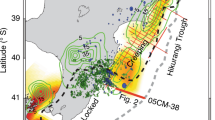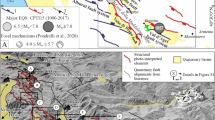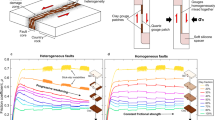Abstract
Understanding the strength and slip behaviour of tectonic faults is a central problem in earthquake physics and seismic-hazard assessment1,2,3,4,5,6,7,8. Many major faults, including the San Andreas Fault, are weak compared with the surrounding rock, but the cause of this weakness is debated1. Previous measurements of the frictional strength of San Andreas Fault rocks are too high to explain the observed weakness1,9,10,11,12,13. However, these measurements relied on samples taken at a distance from the active fault or from weathered surface samples. Recent drilling into the San Andreas Fault9 has provided material from the actively slipping fault at seismogenic depths. Here we present systematic measurements of the frictional properties and composition of the San Andreas Fault at 2.7 km depth, including the wall rock and active fault. We find that the fault is weak relative to the surrounding rock and that the fault rock exhibits stable sliding friction behaviour. The fault zone contains the weak mineral smectite and exhibits no frictional healing—bonds in the material do not heal after rupture. Taken together, the low inherent strength and lack of healing of the fault-zone material could explain why the San Andreas Fault slips by aseismic creep and small earthquakes in central California, rather than by large, destructive earthquakes.
This is a preview of subscription content, access via your institution
Access options
Subscribe to this journal
Receive 12 print issues and online access
$259.00 per year
only $21.58 per issue
Buy this article
- Purchase on Springer Link
- Instant access to full article PDF
Prices may be subject to local taxes which are calculated during checkout



Similar content being viewed by others
References
Scholz, C. H. Evidence for a strong San Andreas Fault. Geology 28, 163–166 (2000).
Moore, D. E. & Rymer, M. J. Talc-bearing serpentinite and the creeping section of the San Andreas Fault. Nature 448, 795–797 (2007).
Schleicher, A. M., van der Pluijm, B. A. & Warr, L. N. Nanocoatings of clay and creep of the San Andreas fault at Parkfield, California. Geology 38, 667–670 (2010).
Collettini, C., Niemeijer, A., Viti, C. & Marone, C. Fault zone fabric and fault weakness. Nature 462, 907–910 (2009).
Niemeijer, A., Marone, C. & Elsworth, D. Fabric induced weakness of tectonic faults. Geophys. Res. Lett. 37, L03304 (2010).
Chester, F. M., Evans, J. P. & Biegel, R. L. Internal structure and weakening mechanisms of the San Andreas Fault. J. Geophys. Res. 98, 771–786 (1993).
Faulkner, D. R. & Rutter, J. H. Can the maintenance of overpressured fluids in large strike-slip fault zones explain their apparent weakness? Geology 29, 503–506 (2001).
Rice, J. R. in Fault Mechanics and Transport Properties of Rocks (eds Evans, B. & Wong, T-F.) 475–503 (Academic, 1992).
Zoback, M., Hickman, S. & Ellsworth, W. Scientific drilling into the San Andreas fault zone. Eos Trans. Am. Geophys. Union 91, 197–198 (2010).
Brune, J. N., Henyey, T. L. & Roy, R. F. Heat flow, stress, and rate of slip along the San Andreas Fault, California. J. Geophys. Res. 74, 3821–3827 (1969).
Lachenbruch, A. H. & Sass, J. H. Heat flow and energetics of the San Andreas Fault Zone. J. Geophys. Res. 85, 6185–6223 (1980).
Zoback, M. D. et al. New evidence on the state of stress on the San Andreas Fault system. Science 238, 1105–1111 (1987).
SAFOD, Photographic Atlas of the SAFOD 3 Cores, (http://earthscope.org/es_doc/data/safod/CorePhotoAtlasv3.pdf), version 3, pp. 51, 58 (2007).
Thayer, M. R. & Arrowsmith, J. R. Fault zone structure of Middle Mountain, Central California. Eos Trans. Am. Geophys. Union 86, T21A-0458 (2005).
Tembe, S. et al. Frictional strength of cuttings and core from SAFOD drillhole phases 1 and 2. Geophys. Res. Lett. 33, L23307 (2006).
Morrow, C. A., Solum, J., Tembe, S., Lockner, D. & Wong, T-F. Using drill cutting separates to estimate the strength of narrow shear zones at SAFOD. Geophys. Res. Lett. 34, L11301 (2007).
Tembe, S., Lockner, D. & Wong, T-F. Constraints on the stress state of the San Andreas Fault with analysis based on core and cuttings from San Andreas Fault Observatory at Depth (SAFOD) drilling phases 1 and 2. J. Geophys. Res. 114, B11401 (2009).
Schleicher, A. M., Tourscher, S. N., van der Pluijm, B. A. & Warr, L. N. Constraints on mineralization, fluid–rock interaction, and mass transfer during faulting at 2–3 km depth from the SAFOD drill hole. J. Geophys. Res. 114, B04202 (2009).
Holdsworth, R. E. et al. Fault rocks from the SAFOD core samples: Implications for weakening at shallow depths along the San Andreas Fault, California. J. Struct. Geol. 33, 132–144 (2010).
Ikari, M. J., Saffer, D. M. & Marone, C. Frictional and hydrologic properties of clay-rich fault gouge. J. Geophys. Res. 114, B05409 (2009).
Thordsen, J. J., Evans, W. C., Kharaka, Y. K., Kennedy, B. M. & van Soest, M. Chemical and isotopic composition of water and gases from the SAFOD wells: Implications to the dynamics of the San Andreas Fault at Parkfield, California. Eos Trans. Am. Geophys. Union 86, T23E-08 (2005).
Marone, C. Laboratory-derived friction laws and their application to seismic faulting. Annu. Rev. Earth Planet. Sci. 26, 643–696 (1998).
Saffer, D. M. & Marone, C. Comparison of smectite and illite frictional properties: Application to the updip limit of the seismogenic zone along subduction megathrusts. Earth Planet. Sci. Lett. 215, 219–235 (2003).
Bos, B. & Spiers, C. J. Effect of phyllosilicates on fluid-assisted healing of gouge-bearing faults. Earth Planet. Sci. Lett. 184, 199–210 (2000).
Carpenter, B. M., Marone, C. & Saffer, D. M. Frictional behaviour of materials in the 3D SAFOD volume. Geophys. Res. Lett. 36, L05302 (2009).
Schleicher, A. M., van der Pluijm, B. A., Solum, J. G. & Warr, L. N. Mineralogical characterization of protolith and fault rocks from the SAFOD Main Hole. Geophys. Res. Lett. 33, L21314 (2006).
Fulton, P. M. & Saffer, D. M. Potential role of mantle-derived fluids in weakening the San Andreas Fault. J. Geophys. Res. 114, B07408 (2009).
Nadeau, R. M. & Guilhem, A. Nonvolcanic tremor evolution and the San Simeon and Parkfield, California, earthquakes. Science 325, 191–193 (2009).
Acknowledgements
We thank S. Haines for X-ray diffraction work and discussions and D. Moore for providing the transmission scanning electron microscope image of the fault-zone material. We also wish to thank N. de Paola and one anonymous reviewer for their comments, which helped improve this manuscript. Finally, we thank S. Hickman, W. Elsworth and M. Zoback for their efforts to initiate and carry out the SAFOD project. This research was funded by the NSF under grants EAR054570, EAR0746192 and OCE-0648331.
Author information
Authors and Affiliations
Contributions
All authors contributed to data analysis and writing. B.M.C. conducted experiments and data analysis.
Corresponding author
Ethics declarations
Competing interests
The authors declare no competing financial interests.
Supplementary information
Supplementary Information
Supplementary Information (PDF 657 kb)
Rights and permissions
About this article
Cite this article
Carpenter, B., Marone, C. & Saffer, D. Weakness of the San Andreas Fault revealed by samples from the active fault zone. Nature Geosci 4, 251–254 (2011). https://doi.org/10.1038/ngeo1089
Received:
Accepted:
Published:
Issue Date:
DOI: https://doi.org/10.1038/ngeo1089
This article is cited by
-
Water Effects on Elastic S-Wave Propagation and Attenuation Across Single Clay-Rich Rock Fractures: Insights from Ultrasonic Measurements
Rock Mechanics and Rock Engineering (2024)
-
Size-Dependent Behaviour of Hard Rock Under Triaxial Loading
Rock Mechanics and Rock Engineering (2023)
-
Frictional behavior of quartz gouge during slide-hold-slide considering normal stress oscillation
International Journal of Coal Science & Technology (2023)
-
Ion complexation waves emerge at the curved interfaces of layered minerals
Nature Communications (2022)
-
Friction in clay-bearing faults increases with the ionic radius of interlayer cations
Communications Earth & Environment (2022)



